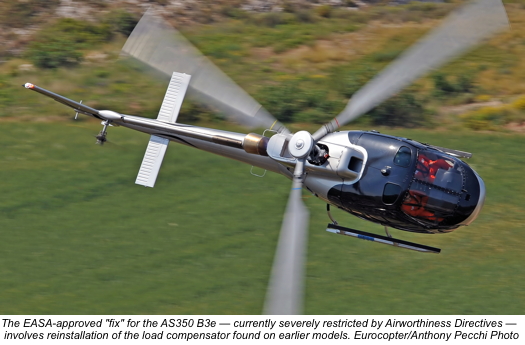
The European Aviation Safety Agency (EASA) has approved a modification that will remove the drastic airspeed restrictions on the Eurocopter AS350 B3e fleet, but it requires reinstallation of the yaw load compensator that the B3e design was intended to eliminate.
On Feb. 8, EASA published Airworthiness Directive (AD) 2013-0029, which supersedes previous EASA ADs for the B3e. In addition to the airspeed restrictions and inspection requirements of previous ADs, the new AD requires B3e operators to complete Eurocopter Modification 07 5606 within five months of the AD’s effective date of March 1, 2013.
Helicopters that have undergone MOD 07 5606 will no longer be limited to the never-exceed speed (VNE) of 100 knots that was imposed on B3e models last year in response to several accidents and incidents related to failures of the tail rotor laminated half-bearings. In this respect, the modification is the highly anticipated fix that will restore the B3e fleet to full capability and the certified VNE of 155 knots.
However, MOD 07 5606 requires the removal of the additional balancing weights on the B3es tail rotor, and installation of a compensator lever on the yaw channel — effectively restoring it to the previous B3 configuration and eliminating one of the model’s selling points.
The AS350 B3e was unveiled at Heli-Expo 2011 as the enhanced version of Eurocopter’s best-selling AS350 B3 helicopter. Powered by a high-performance Turbomeca Arriel 2D engine with a new-generation full authority digital engine control (FADEC), the B3e promised reduced operating costs thanks to the Arriel 2D’s lower specific fuel consumption and extended time before overhaul.
But Eurocopter also touted hydraulic system and flight controls improvements in the B3e, which it said would enhance reliability and decrease maintenance. The primary improvement was the removal of the B’3s yaw load compensator, and the installation of additional balancing weights on the tail rotor in order to reduce the static control load.
The yaw load compensator has always been a compromise: a solution to the high zero pitch return moment of the increasingly large aft tail rotor blade surface area on B1 and higher models. With the aircraft’s hydraulic system operating, the servo actuator hydraulic pressure overcomes the rotor’s zero pitch return moment and cancels out the control reversal. Without any hydraulic pressure, however, the pedal operating force is extremely high. The yaw load compensator, which is installed in parallel with the tail rotor servo actuator, provides the assist required for an average pilot to control the aircraft in the event of a hydraulic system failure.
Although effective, the yaw load compensator adds weight and complexity to aircraft in which it is installed. With the B3e, Eurocopter appeared to provide an elegant alternative to the system: instead of a load compensator, B3e models had additional balancing weights added to the tail rotor to provide the necessary reduction in pitch control loads.
Unfortunately, the added weights caused an unforeseen problem: excessive stress on the laminated half-bearings that orient the inner root of the tail rotor blade to the fiberglass spar.
An accident that occurred on Sept. 28, 2012 provided Eurocopter with enough information to act. During the flight on which the accident occurred, the pilot felt strong vibrations originating from the tail rotor before losing control of the helicopter. Previously, all the laminated half-bearings of this aircraft had been replaced twice, after having logged few flying hours.
As a precautionary measure, Eurocopter quickly issued a mandatory limitation of the flight envelope for the B3e (and for the military version of the aircraft, the AS550 C3e Fennec). It also required more frequent inspections of the laminated half-bearings. These measures were subsequently adopted as Airworthiness Directives by EASA and other aviation authorities.
Eurocopter told Vertical that the manufacturer will support the cost of parts and associated installation man-hours for MOD 07 5606, which is required to be carried out by Eurocopter personnel. The company stated, “After implementation of this modification, the current VNE reduction will be removed and therefore, initial B3e flight performances will be fully restored. The entire B3e/C3e fleet retrofit will be completed by August 2013 and Eurocopter confirms that we are in line with the schedule defined.” Going forward, Eurocopter said the modification will have no impact on new B3e prices.
United States Federal Aviation Administration (FAA) Mid-States public affairs manager Lynn Lunsford confirmed that the FAA is currently reviewing a request of validation from EASA for the B3e fix, but declined to specify a timeline for approval.









